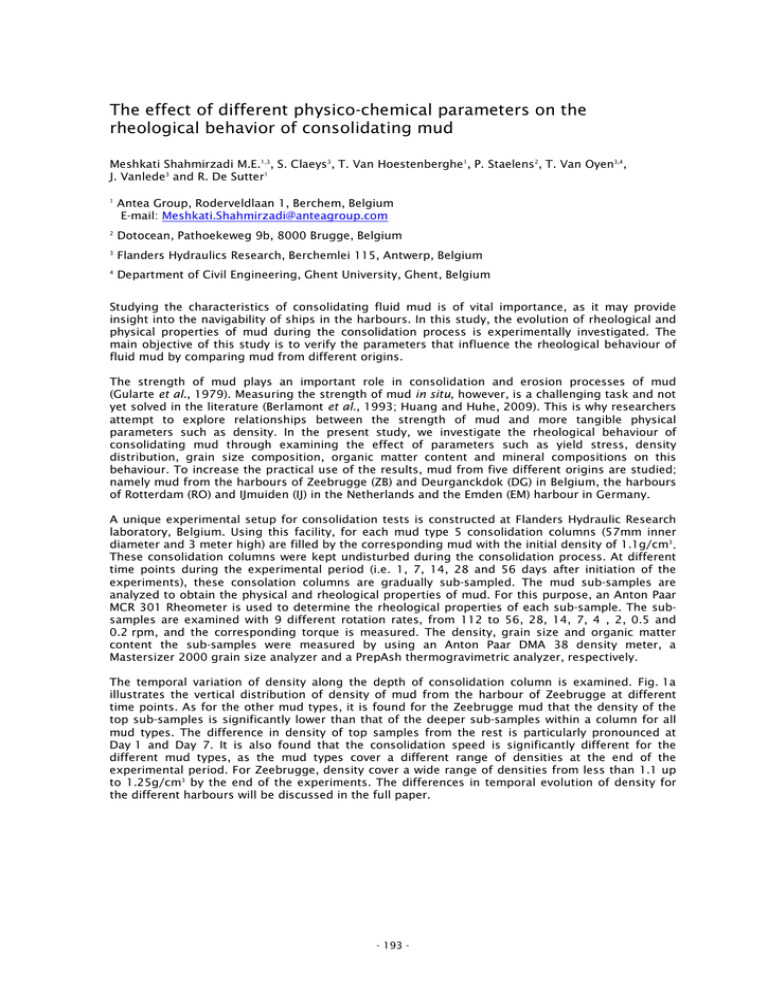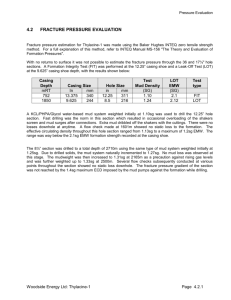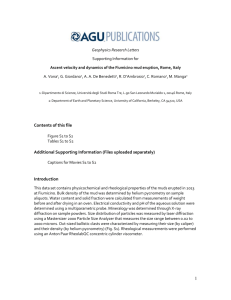The effect of different physico-chemical parameters on the
advertisement

The effect of different physico-chemical parameters on the rheological behavior of consolidating mud Meshkati Shahmirzadi M.E.1,3, S. Claeys3, T. Van Hoestenberghe1, P. Staelens2, T. Van Oyen3,4, J. Vanlede3 and R. De Sutter1 1 Antea Group, Roderveldlaan 1, Berchem, Belgium E-mail: Meshkati.Shahmirzadi@anteagroup.com 2 Dotocean, Pathoekeweg 9b, 8000 Brugge, Belgium 3 Flanders Hydraulics Research, Berchemlei 115, Antwerp, Belgium 4 Department of Civil Engineering, Ghent University, Ghent, Belgium Studying the characteristics of consolidating fluid mud is of vital importance, as it may provide insight into the navigability of ships in the harbours. In this study, the evolution of rheological and physical properties of mud during the consolidation process is experimentally investigated. The main objective of this study is to verify the parameters that influence the rheological behaviour of fluid mud by comparing mud from different origins. The strength of mud plays an important role in consolidation and erosion processes of mud (Gularte et al., 1979). Measuring the strength of mud in situ, however, is a challenging task and not yet solved in the literature (Berlamont et al., 1993; Huang and Huhe, 2009). This is why researchers attempt to explore relationships between the strength of mud and more tangible physical parameters such as density. In the present study, we investigate the rheological behaviour of consolidating mud through examining the effect of parameters such as yield stress, density distribution, grain size composition, organic matter content and mineral compositions on this behaviour. To increase the practical use of the results, mud from five different origins are studied; namely mud from the harbours of Zeebrugge (ZB) and Deurganckdok (DG) in Belgium, the harbours of Rotterdam (RO) and IJmuiden (IJ) in the Netherlands and the Emden (EM) harbour in Germany. A unique experimental setup for consolidation tests is constructed at Flanders Hydraulic Research laboratory, Belgium. Using this facility, for each mud type 5 consolidation columns (57mm inner diameter and 3 meter high) are filled by the corresponding mud with the initial density of 1.1g/cm3. These consolidation columns were kept undisturbed during the consolidation process. At different time points during the experimental period (i.e. 1, 7, 14, 28 and 56 days after initiation of the experiments), these consolation columns are gradually sub-sampled. The mud sub-samples are analyzed to obtain the physical and rheological properties of mud. For this purpose, an Anton Paar MCR 301 Rheometer is used to determine the rheological properties of each sub-sample. The subsamples are examined with 9 different rotation rates, from 112 to 56, 28, 14, 7, 4 , 2, 0.5 and 0.2 rpm, and the corresponding torque is measured. The density, grain size and organic matter content the sub-samples were measured by using an Anton Paar DMA 38 density meter, a Mastersizer 2000 grain size analyzer and a PrepAsh thermogravimetric analyzer, respectively. The temporal variation of density along the depth of consolidation column is examined. Fig. 1a illustrates the vertical distribution of density of mud from the harbour of Zeebrugge at different time points. As for the other mud types, it is found for the Zeebrugge mud that the density of the top sub-samples is significantly lower than that of the deeper sub-samples within a column for all mud types. The difference in density of top samples from the rest is particularly pronounced at Day 1 and Day 7. It is also found that the consolidation speed is significantly different for the different mud types, as the mud types cover a different range of densities at the end of the experimental period. For Zeebrugge, density cover a wide range of densities from less than 1.1 up to 1.25g/cm3 by the end of the experiments. The differences in temporal evolution of density for the different harbours will be discussed in the full paper. - 193 - Fig. 3a. The temporal evolution of density along the depth in the Zeebrugge consolidation column. Fig. 1b. Equilibrium flow (EF) curves for Zeebrugge. Equilibrium flow (EF) curves are obtained with Rheometer tests using a vane. In Fig. 1b the EFC for different densities are shown for Zeebrugge. It is found that the general pattern of EF curves is independent of density and follows a similar trend for all the studied mud types. All studied mud types showed a non-Newtonian shear thinning behaviour. A typical upward shift is recognized in EF curves as density rises. The upward shift between EF curves in respect to the rise in density is more or less equal till a certain level of density. Beyond this level, a big jump in EF values is observed. For Zeebrugge a density level higher than 1.20g/cm3 demonstrates a sharp increase in the EF values (Fig. 1b). A further descriptions of the EF curves of different studied mud types will be presented in the full paper. A comparison of the temporal evolution of grain size distribution and organic matter content of different studied mud types will be presented. The study on the grain size distribution includes a detailed examination of the fractions of clay, silt and sand in each mud type as well as the span (width of the cumulative grain size distribution curve), the surface mean and the volume mean of grains. The results of clay mineralogy tests will be analyzed to investigate whether the mineralogical characteristics of mud affect the rheological behaviour of fluid mud. The mineralogical study includes the determination of the following parameters: CaCo3, clay minerals (XRD-analysis), CEC and pH. Acknowledgments This project is funded by the department Maritime Access from the Flemish Government. Both first authors have evenly contributed to the results of this project. References Berlamont J., M. Ockenden, Erik. A Toorman and J. Winterwerp. 1993. The characterization of cohesive sediment properties. The characterization of cohesive sediment properties. Coast. Eng. 21:105-128. Gularte R.C., W.E. Kelly and V.A. Nacci. 1979. Rheological methods for predicting cohesive erosion. p.251-258. In: Proc. 15th Annual Conf. of the Marine Technology Soc., New Orleans, LA. Huang Z. and A. Huhe. 2009. A laboratory study of rheological properties of mudflows in Hangzhou Bay, China. International Journal of Sediment Research 24:409-423. - 194 -






